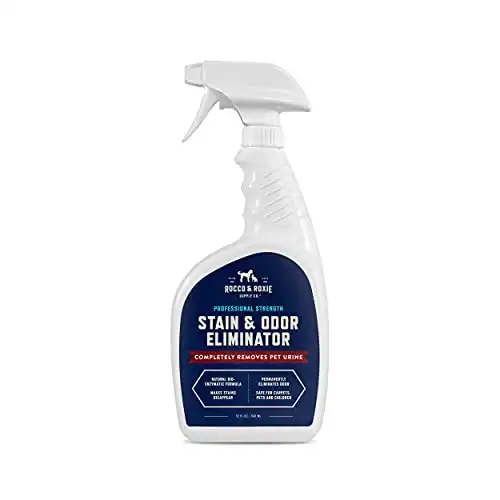Why Does My Maltipoo Keep Peeing In The House
An unsuspecting foot squelches into a puddle. Ew! Ever had the problem of dog pee EVERYWHERE?
Just how much can this one TINY Maltipoo pee!
Dog pee on the floor. Dog pee on the bed. Dog pee on the carpet! Why does my Maltipoo keep peeing in the house?
Maltipoos are such cute Oodle Dogs, but the smell of pee in the house is not-so-cute.
Side stepping (or stepping in) pee puddles is a pain. Not to mention the nuisance of having to clean up afterward, especially scrubbing it off from the carpet or bed!
If you have a Maltipoo that just seems to love to pee EVERYWHERE – read on to find out how to solve it.
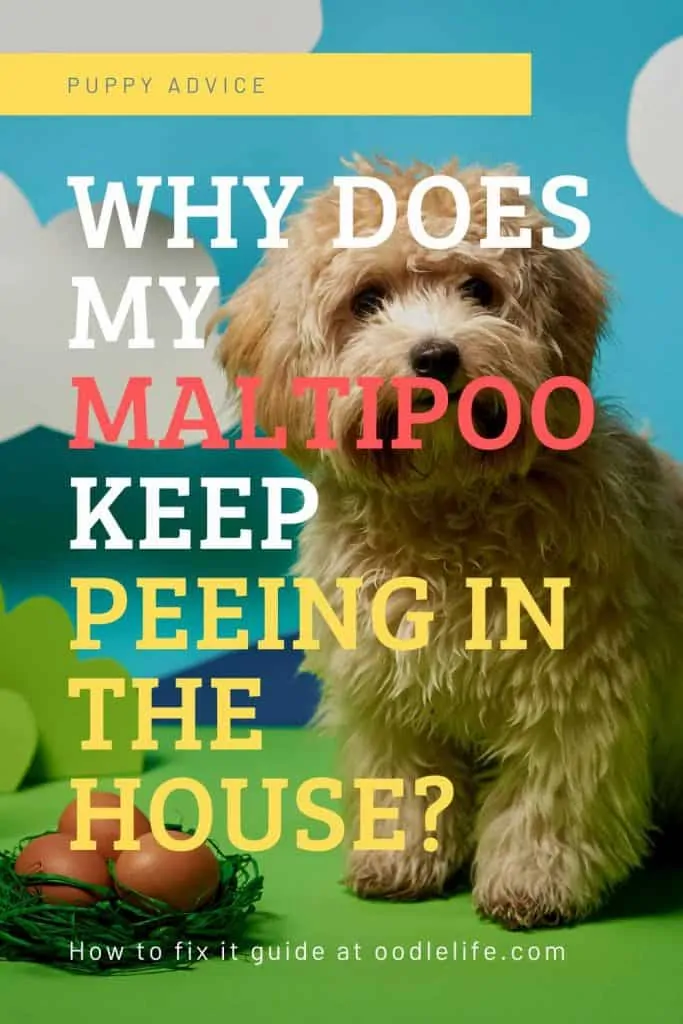
Why does my Maltipoo puppy keep peeing inside?
House training is usually completed very early on in puppyhood, but if your puppy doesn’t seem to be learning, what might be the reason?
Lack of training
If you haven’t trained your Maltipoo to pee in the right place, it’s really not its fault because it doesn’t know any better. Another factor is that you may not be training it properly. Training requires a lot of attention, patience, commitment, and an understanding of how positive and negative reinforcement works.
It may be scared!
Heard of peeing your pants when you’re scared? Heck, even humans tend to urinate more when they are frightened. So do dogs sometimes, especially submissive ones. It is also more common in puppies compared to grown-up dogs.
Even big dogs like the Bernedoodles or Labradoodle can be scared sometimes. It is one of the reasons that Labradoodles do not like to live alone outside!
This can be triggered by a stranger or even you! Suppose you assume a threatening or intimidating pose or scold your puppy harshly. In that case, you will definitely scare it, and it may pee on the spot. It might also be afraid of being left alone or frightened of unwelcome noises.
If this is why it’s easy to figure out straight away because it will only act off in abnormal circumstances and otherwise behave entirely well.
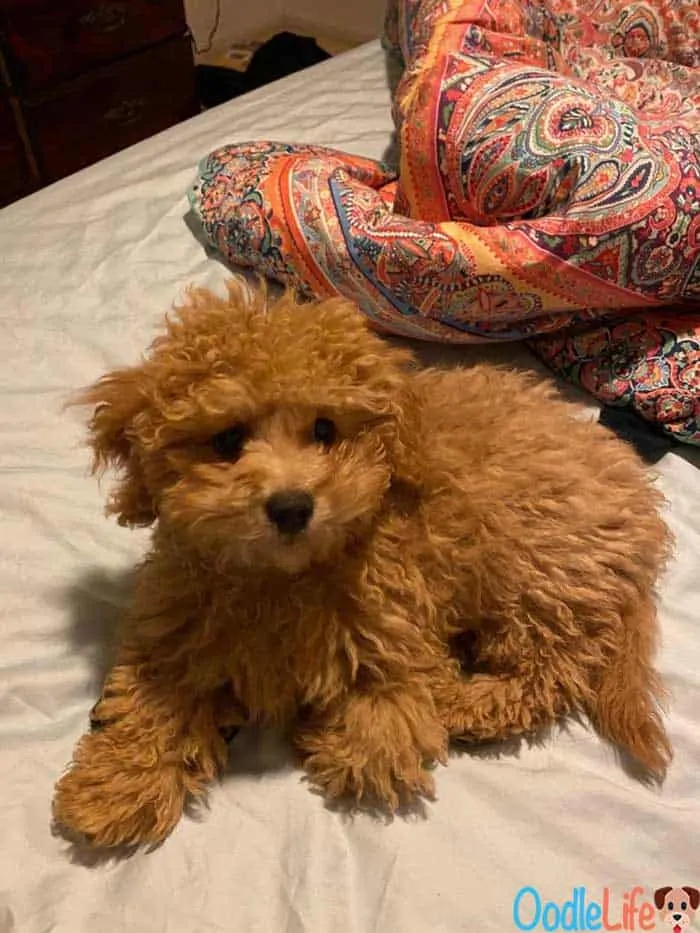
On the other hand, it may be too excited.
Overexcitement is also a completely opposite but common reason. Even though it’s more common in puppies, your Maltipoo may even carry this behavior into adulthood.
Your puppy just may be super excited to see you or someone else it likes or just thrilled at the doorbell’s sound. Whatever the case, it could be happily jumping and jiggling as it sprays urine all over the floor.
Is your Maltipoo drinking too much?
Is there a chance your Maltipoo is drinking too much? It might be time for an intervention.
Increased water intake can also be a reason your dog keeps going inside the house. This is usually linked to some health problems. Your vet may use the term “polydipsia” or “polyuria” to describe this condition i.e., more drinking and more urinating.
You need a better toilet solution.
Maybe your Maltipoo doesn’t go outside too often, or it’s a longer hassle stepping outside. You need a closer, indoor solution for your puppy then, so it doesn’t wet the wrong places. There are many indoor toilet solutions available in the market, the most common being “pee pads” like indoor grass patches with a plastic collector that can be easily cleaned.
Urinary Incontinence
This is an involuntary loss of urine and usually occurs in spayed or neutered female dogs. You will observe that your dog leaves the place wet where it’s been lying down or sleeping. It urinates just fine, usually when it’s up and about but doesn’t have control while resting or relaxing.
Urinary Tract Infection (UTI)
A Urinary Tract Infection (UTI) is the most common infection in dogs and presents in a whopping 14% of dogs that require Veterinary care (Study by Ball, Rubin et al from the Western College of Vet Medicine).
Sometimes the reason can be much more severe. Your dog may have some severe disease-causing urinary tract infections, which increases its urgency to pee. This is also painful and is accompanied by other symptoms, too like blood in the urine, having difficulty while peeing and licking that part excessively. You must get an appointment with a vet immediately.
Aging
If your Maltipoo is getting very old, then that may be the reason for the loss of bladder control. Firstly, health issues like kidney failure are more common in old age. Secondly, other problems like dementia or becoming senile also occur in old age and lead to house soiling. So even a well-trained dog can start regressing in old age.
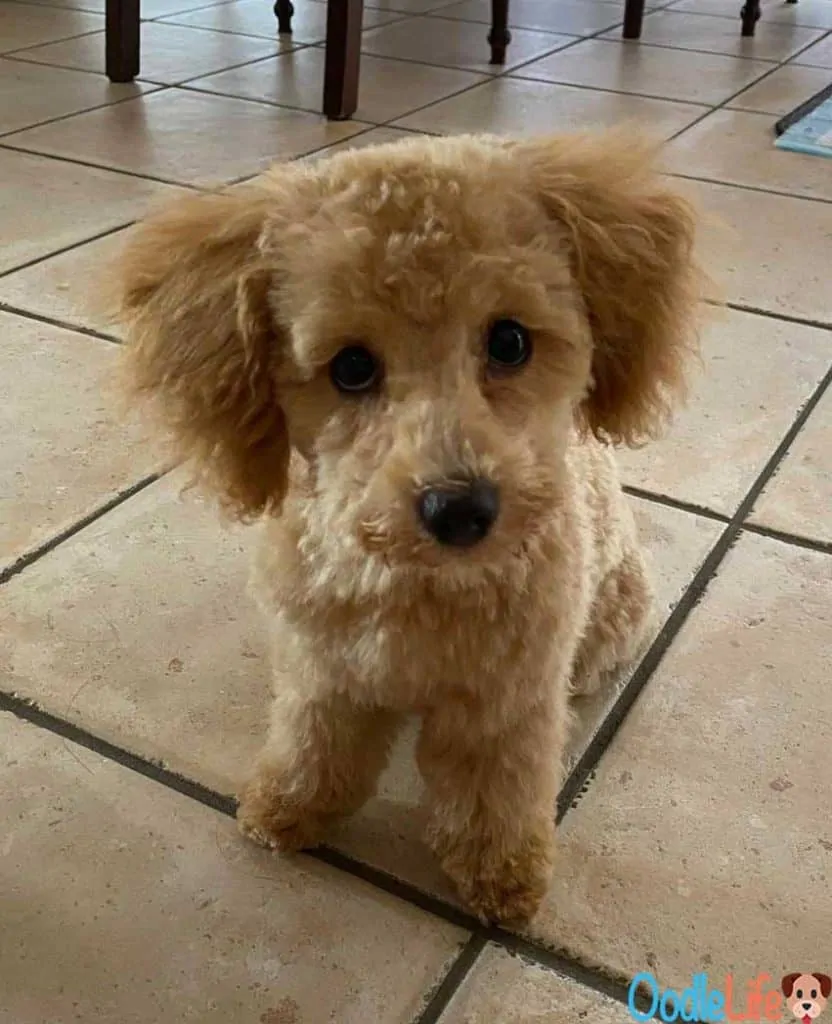
Change in routine or environment
If your well-trained Maltipoo starts soiling the house, it may be because of some sudden change that caused it to stress. This can be due to a change in its surroundings. Have you shifted to a new place or introduced a new pet in the home? This would just take some getting used to and re-training.
Acting out
If there is no health issue, then this just might be a behavioral problem i.e., your Maltipoo is just “acting out.” Male dogs often display marking behavior, and this is hormonal. These behavioral issues are often triggered by some change in the environment, as discussed earlier, causing the puppy to stress. They can be corrected with better training.
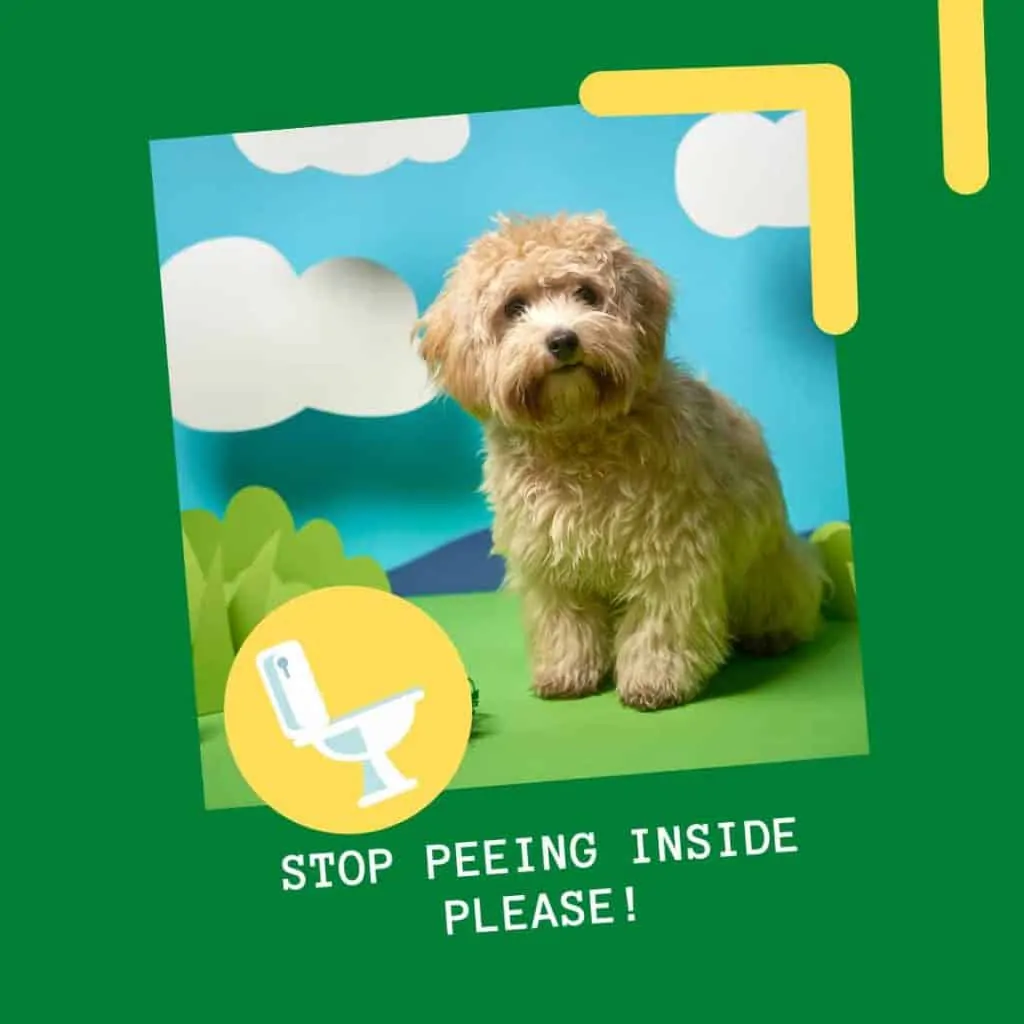
Clean up thoroughly (and use the right cleaning agent) to prevent re-accidents
Not only is this obvious if you want to prevent smell, accidents, or stepping into pee puddles yourself, but it is also important to discourage your puppy from peeing indoors.
Use an enzymatic cleaner to clean the spot so that there is no trace left, not even a slight smell. You need to do this EVERY SINGLE TIME! Be hyper vigilant.
If you don’t do it properly and quickly, and it still smells of pee, your dog will pick up the scent and assume it is okay to pee indoors, which it is not!
The best enzymatic urine cleaner is Rocco & Roxie Supply Professional Strength Stain and Odor Eliminator.
- CERTIFIED GENTLE AND SAFE Chlorine free and color safe. Safe to use around pets and children. No hazardous propellants, no residue left behind. So gentle it’s been Certified Safe for all carpets, earning the Seal of Approval by the trusted Carpet and Rug Institute (CRI)
- ELIMINATES STAINS, ODORS AND RESIDUE If it’s gross, it’s gone. Not just the stain, but the stink. From stinky yellow pet urine and feces to vomit and other organic spills, our professional strength formula tackles them all.
- EVERY SURFACE, EVERY TIME For use on carpets, floors, furniture, clothing, litter boxes, kennels, carriers, all pet living and sleeping areas—anywhere stains happen.
- ENZYME ACTIVATED The key is getting to the problem deep-down. This spray contains natural enzymes that are activated on contact with odors and stains, feeding on ammonia crystals and organic matter until they are completely eliminated.
- 100% SATISFACTION GUARANTEED
It is the best choice on the market because
- It is a professional grade (aka super strong). Not only does it destroy the proteins that allow dogs to smell the urine – it dominates odors that are offensive to humans. In short? Goodbye, smelly accident FOR GOOD
- It is, of course, a robust enzymatic cleaner that destroys the proteins. This means deep cleaning that will eliminate confusion for your dog. If it doesn’t smell like a pee spot – the dog will not pee there.
- Despite being strong, it is okay for use on all surfaces (carpet to wood to… etc.) Spot test first, but it is chlorine-free, so don’t expect any troubles.
A spray bottle goes a long way when potty training a Maltipoo. Wipe it first, use the spray second – and you are golden.
If your Maltipoo does end up smelling a little funky during toilet training – use a quality budget friendly shampoo to clean their coat. Pick a puppy shampoo that matches their amazing non-shedding coat (our best shampoos in this list work great for Maltipoo hair).
How long should it take to house train my Maltipoo?
If you want to know at what age your Maltipoo should stop peeing inside the house, then don’t worry because it doesn’t take long. Generally, puppies gain full bladder control at 4-6 months of age. So if you have been training it since the start, it shouldn’t take more than that to become fully trained. Don’t panic if it takes longer, though, as this is just an average number.
How to properly house train your Maltipoo
Now that we’ve gone through why your dog keeps going inside the house, we’ll talk about how you can stop this behavior.
Take your dog out more often
On average, a dog needs to go out 3-5 times a day to pee. But this largely varies with age, breed of dog, and diet. A puppy needs to go out much more often. As a simple rule, you should suppose that a puppy can only hold it in for an hour plus how old they are in months.
If your puppy is a month old, then 2 hours is a good guess. If your dog is much older, then 4-6 hours is good enough. You should also take your puppy out fifteen minutes after eating and drinking.
When you’re starting to train a puppy, it’s great to take it out very often. Every hour, if you can, would be great for training.
Control water intake
Some dogs just go WILD if there is free for all water available. it is after all an all you can drink buffet!
We’re not asking you to starve it of hydration, of course, but just make sure it doesn’t drink too much water. Give it food and drink after good breaks so that you don’t spoil it, and it gets used to a routine.
Supervision
Training requires attention and constant supervision. If you do not have that kind of time, you could hire a pet sitter or trainer for the job so that you don’t leave your dog unattended.
It is a frustrating thing that we cannot be there for our dogs as much as we would like. This is a key factor when deciding to get a dog if you work full time (and how to make it work).
Professional help
Suppose your dog’s behavior is too much for you to handle. In that case, you should definitely consult a proper trainer or behaviorist who can identify the issue and deal with it.
Paid help exists for a reason – most issues can be easily ironed out at home once you identify the cause. If the acting out is just too much or the root cause is a mystery – look at local dog groups on Facebook for recommendations of good local trainers.
Give it time
Be patient, and don’t expect your puppy to pee in a rush. You should give at least a good ten minutes every time you take him out to pee. This is because dogs sometimes take time to get comfortable and find a spot they like. Let it relax.
Find a good toilet solution
If you can’t take your dog out to relieve itself frequently, then you should have a dedicated spot inside. Even if you do take it out, there should be an inside toilet, especially to allow for bad weather outside or get too busy to step out. There are lots of solutions available. Ensure a right pee pad or patch inside, which is easily and quickly accessible at all times.
Positive reinforcement
Always reward your Maltipoo whenever it pees at the right place and right time. This can mean patting it, verbal appreciation, and giving it treats and toys. This is the best way to train.
You must avoid yelling, scolding, or hitting at any cost as that will scare your puppy and make everything worse. It will not help to train it at all. If you disapprove of something, say it mildly with your words and expressions and maybe pull your dog away from the spot or take away something it likes to play with for a while.
Don’t scare the dog. This gains NOTHING.
